Honda X-ADV test: the Integra takes the right path

Five years after the Integra, the first maxi-scooter built from a motorcycle as convincing dynamically as it is disappointing on a practical level, Honda pushes this curious mixture of genres even further by exploring with the new X-ADV a completely unexpected: the all-terrain ! And this time, the concept hits the mark ….
X-ADV test Page 3: MNC technical point
Engine
Built from the Integra, the X-ADV logically takes its parallel twin cylinder set at 270 ° characteristic of the NC750 series. No major changes are made to this 745cc engine, except for specific injection mapping and 5% shorter gear ratios on the first five gears.

The X-ADV develops – like the Integra – 54.8 hp at 6,250 hp and 68 Nm of torque at 4,750 rpm. It also receives a redesigned exhaust in the raised position, very elegant because it is covered with a beautiful aluminum plate. Rather basic, this long-stroke in-line twin (77 mm bore x 80 mm stroke) receives a single camshaft distribution to drive its four valves per cylinder.
This twin is very tilted forward (62 °) in order to lower the center of gravity and free up space. Sober ("3.63 l / 100 km", according to Honda with the DCT gearbox in D mode), this engine eliminates internal friction to reduce consumption: the pistons are thus covered with a special resin and the cams are extremely light aluminum. In addition, the operation of each part is optimized: the water pump is driven by the camshaft and the oil pump is fixed on the same axis as the double balancer shaft. And if the twin has one injector per cylinder, the admission is done through a split duct with a single butterfly.
Finally, the last "mechanical" trick to prevent it from consuming, an ignition failure placed at only … 6500 rpm! During this test, MNC noted an average consumption of 5.1 liters / 100 km on the instrument panel. Enough to ensure important relays with the 13.1 liters of gasoline contained in the tank (one liter less than that of the Integra).
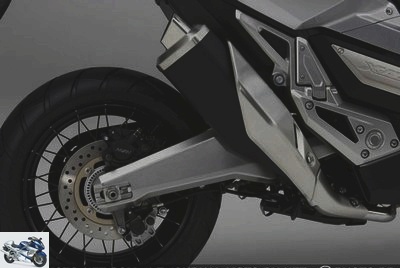
Economical, the X-ADV benefits from service intervals of 12,000 km while its iridium spark plugs will have to be replaced at 48,000 km. The final chain transmission is one of the negative points for a scooter: you have to see the constraints of platform sharing, since the X-ADV uses the same components as the motorcycles of the NC750 series.
The presence of a casing that largely protects this chain from projections and of a standard central stand to lubricate it will not be enough, for some, to erase the constraints of this type of transmission, both less clean and more demanding. in maintenance than the belt of a Yamaha Tmax, for example. We console ourselves – a little – with the pretty 2.5 mm aluminum shoe placed under the twin cylinder, in order to protect it from impacts: practical in case of "crossing" sidewalks
Equipped with a catalytic system – in two parts – and a catalyst directly placed at the engine output to promote its efficiency when cold, this vertical twin-cylinder adopts the DCT double-clutch gearbox as standard. More responsive – but still just as heavy (10 kg) – this Dual Clutch Transmission regularly receives improvements to gain in pleasure and sensitivity (read below).
Cycle part
Like the NC750X and NC750S motorcycles and the Integra scooter, the cycle part of the X-ADV is based on a "Diamond" type frame made of steel tubes. Simple to manufacture – and therefore inexpensive – this double cradle leads to an elegant aluminum swingarm specific to the Integra and X-ADV (in steel on the NC750).
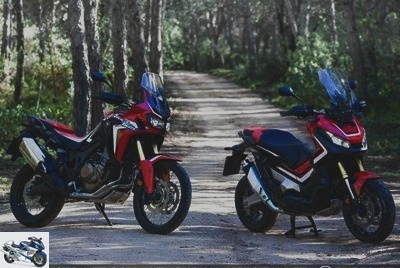
To enhance its status as an adventurer, the X-ADV adopts suspensions and brakes accordingly: the non-adjustable telescopic fork of the Integra gives way to an inverted model with a diameter of 41 mm, whose preload and rebound can be adjusted. adjust. In addition, this more upscale equipment struggles on 153.5 mm in height, against 120 mm on the Integra.
Same story at the rear, with a mono-shock absorber mounted on rods and adjustable in preload by 150 mm of travel on the X-ADV, against 120 mm on the Integra. This elevation allows the X-ADV to offer an image "higher on legs" and increases its ground clearance, to 165 mm against 135 on the Integra (+ 30 mm). In return, the saddle height also climbs to reach 830 mm, against 790 on the "road" scooter (+ 40 mm).
Braking is seriously reinforced on the X-ADV by means of a device now with twin 296 mm discs (only one on the Integra), clamped by two radial-mounted 4-piston calipers (a single 2- caliper) axial pistons on the Integra). These are nothing less than the Africa Twin’s calipers. The standard ABS is not coupled and cannot be deactivated: a pity for off-road incursions, theoretically possible with this Integra with Africa Twin sauce !
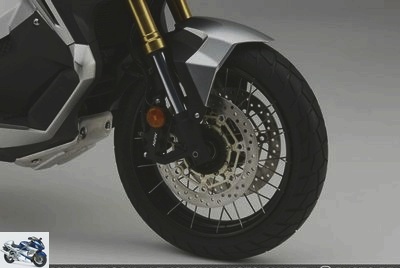
Other important changes between the X-ADV and the Integra: the introduction of spoked wheels – with angled valves – on the novelty, to reinforce its all-terrain accent. The most observant will note that the diameter of the rear rim decreases in passing, going from 17 inches on the Integra to 15 inches on the X-ADV …
The purpose of the maneuver is obvious: to free up additional space in order to increase the volume of the trunk located under the saddle. To accommodate more space, engineers also widened the rear frame. All these modifications combined with the additional travel allow the X-ADV to offer a 21-liter cargo bay, capable of accommodating a full-face helmet of good size, unlike the Integra on which the carrying of a helmet is impossible..
End of the day: the interior receives LED lighting and a 12 V socket. The only downside to this transformation: Honda did not settle for installing a wheel that was two inches smaller to be able to fit out a "real" trunk. , the volume of the fuel tank also decreases by one liter (13.1 l against 14.1 on the Integra).
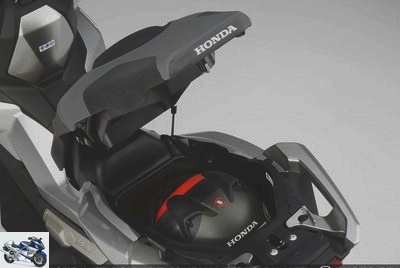
Remember that the tank is located under the saddle on the NC750 (and therefore the X-ADV). But unlike motorcycles and the Integra, there is no need to get off the two-wheeler and lift the seat to refuel: Honda cleverly installed a hatch on the front of the seat, including the opening is controlled from a button located under the contactor.
Despite all these adjustments, the fundamental geometric values of the X-ADV remain fairly close to those of the Integra: the caster angle is identical (27 °) and the shank decreases slightly, to 104 mm against 110 mm on the Integra . This decrease aims to compensate for the increase in the wheelbase, increased to 1590 mm on the X-ADV against 1525 mm on the Integra. The announced weight remains, strangely, at the same threshold on both: 238 kg in running order. The weight distribution is neat, with 51% on the front and 49% on the rear.
Electronics and DCT dual clutch transmission
In terms of electronics, the X-ADV goes straight to the point, unlike a Yamaha Tmax (with traction control and Ride-by-wire in 2017) or a BMW C650 Sport (anti-slip, automatic parking brake, etc.). The new Honda features ABS – non-combined and non-disengageable – injection, contactless starting … and that’s it !
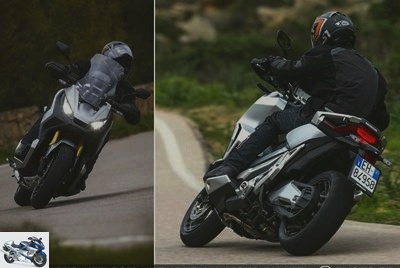
Like the Integra, its main on-board technology is its dual-clutch transmission (DCT), the "house" device derived from the automobile and adapted by Honda for use on two-wheelers. Unique in motorcycle production (not in cars, where it has been used for about 15 years), this DCT is based on a conventional gearbox, with forks and barrels, connected to two multi-disc clutches in oil bath.
Managed by an electronic control unit and hydraulic circuits, the first clutch deals with odd gears (1st, 3rd and 5th) and the second with even gears (2nd, 4th and 6th). When the first is switched on, for example, the central unit pre-switches – in just 70 milliseconds! – the second gear, then releases the clutch of the first at the same time that the second gear is locked.
The X-ADV is therefore devoid of a clutch lever and offers two operating principles. The first is 100% automatic (AT) and is subject to two modes with preprogrammed reactions: "D" for Drive and "S" for Sport. In practice, this "AT" function is the one used most of the time. Since 2016, this "S" mode includes three more or less sporty sub-maps, revealed by Honda last year on its NC750 range..
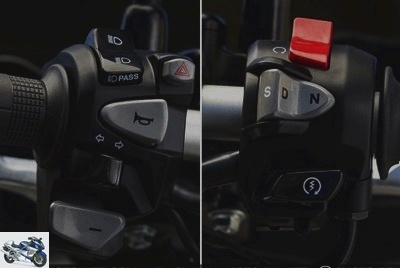
The "S1" mode is the most suitable for a smooth and smooth ride, while the "S2" corresponds to the previous "Sport" mode. S3 mode is more dynamic, both in terms of responsiveness and engine braking. Note that each mode has been muscular to boost the respondent of the X-ADV and that the gear change occurs 500 rpm later for the same reason.
Switching from D to S mode is done from the dedicated control on the right and the maps switch by long pressing the "S" button when Sport mode is engaged. Everything can be done while driving, without turning off the throttle, quite easily and intuitively. In addition, as on the Africa Twin DCT, the system now has adaptive control to manage the torque transmitted to the clutch, in particular to adapt to the fact that one is up or down a gear..
On paper, Honda says the feel is "more natural" when you cut or re-go. In practice, the DCT is indeed more and more transparent in its reactions.In addition, as on the Africa Twin, the DCT of the NC750 integrates a calculation system to adapt to the longitudinal inclination: by comparing the engine speed , speed and degree of throttle opening, the ECU manages to determine whether the road is going up or down. This allows the DCT to avoid shifting into gear at an inopportune moment, such as upshifting down a hill for example..

The second mode of use (MT) proposed by the DCT is of the semi-automatic type, with up and down gears "by hand" via the "+" and "-" triggers on the left stalk. When the engine is started, the system is automatically placed in neutral. All that remains is to choose between automatic "D" or "S" modes or to actuate the "AT / MT" tab placed behind the right stalk – like flashing of the headlight – to engage the "manual" mode..
However, even in manual mode, the system "filters" the orders deemed unnatural: impossible to downshift when the engine speed is too high… which happens quickly with only 6500 rpm available! Under-revs caused by upshifting several gears without accelerating is also impossible. Likewise, the system will automatically return to 1st as soon as it stops..
At any time, it is possible to switch from automatic to manual, and vice versa. The gear and mode engaged are clearly indicated by the new on-board console. Designed for calm driving or duoing, the automatic "D" mode shifts smoothly and quickly, often between 2500 rpm and 3000 rpm, or at 90 km / h in 6th gear. In built-up areas, it stalls in fourth at 50 km / h, which translates into an immediate downshift as soon as you put the throttle on to double.
More lively, the "S" mode generates a few jerks, especially during downshifts in the first reports. The three S mode subroutines then provide flexibility, especially in the wet where we appreciate the extra softness of S1 mode.
Finally, it is possible to manually increase or decrease a gear even in automatic mode, in order to downshift before a curve for example. However, an "auto-return" function means that after a few seconds without any action on the pallets, the system returns to the selected automatic configuration ("D" or "S").
Related articles
-
2016 Honda Integra review: complete, but incomplete… Bringing together the qualities of a motorcycle and a scooter: such has been the ambition of the…
-
Scooter – Honda Integra test: the scooter for bikers? – Mechanical update on the 2012 Honda Integra
Honda Integra test : the scooter for bikers ? Technically identical to the NC700X trail and the NC700S roadster, the Integra is however radically…
-
Trail – Honda NC750X test: X without mischief – 2016 Honda NC750X: MNC technical update
Honda NC750X test: X without malice Thanks to a relevant stylistic overhaul and the provision of practical improvements, the 2016 Honda NC750X is…
-
Honda NC700S test: a good bike in every way ? Combine utility with pleasure: here is the bet launched by Honda with its new entry-level motorcycle, the…
-
2014 Honda CTX700 review: not so simple ! At first glance, the Honda CTX700 is just a new bagger type offshoot from the NC700 platform. Either a kind of…
-
Africa Twin 2016 test: Honda takes over from the desert Basically, a trail is a motorcycle that is easy to handle and comfortable on all terrains. Honda…
-
New 2021 Honda Forza 750 test: stronger than the Tmax ?! Honda is putting pressure on the Tmax with this new Forza 750 maxi-scooter, a relevant mix…
-
2018 Honda Goldwing Touring test: more watts, less cotton wool On an exceptional motorcycle, exceptional measures: after 17 years without major…
-
Honda X-ADV test: the Integra takes the right path Five years after the Integra, the first maxi-scooter built from a motorcycle as convincing dynamically…
-
Honda X-ADV test: the Integra takes the right path Five years after the Integra, the first maxi-scooter built from a motorcycle as convincing dynamically…